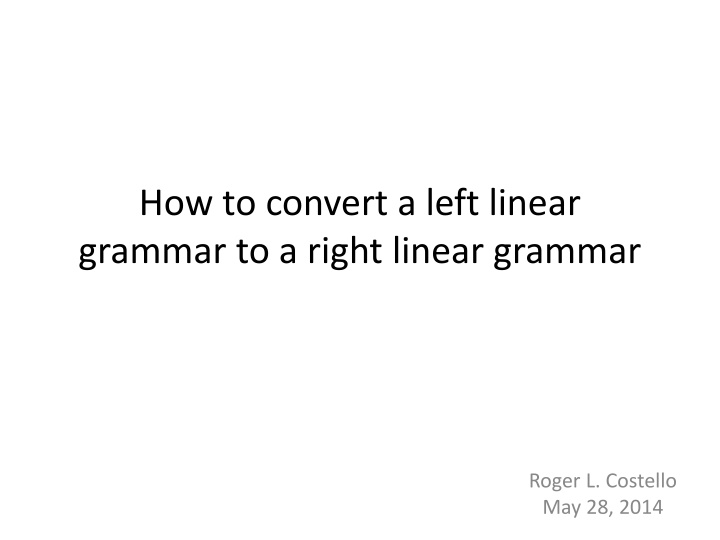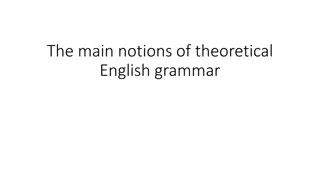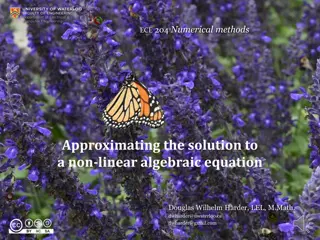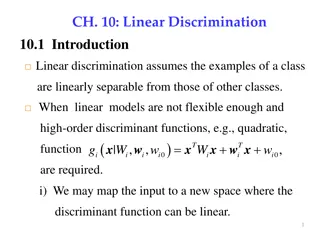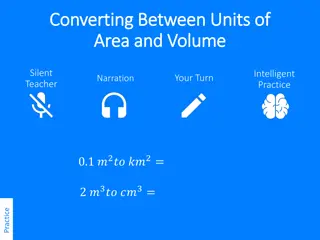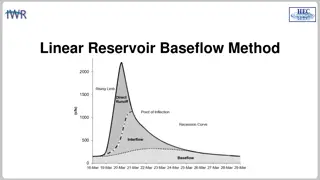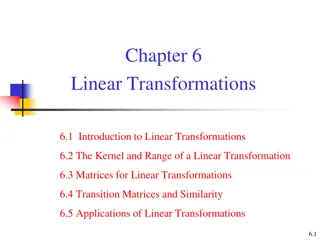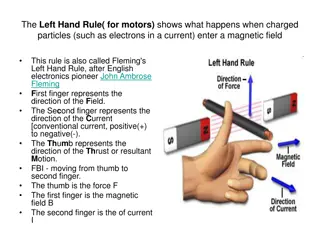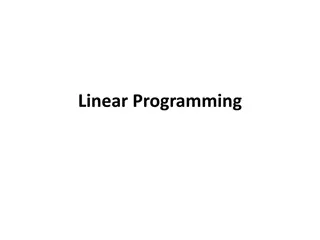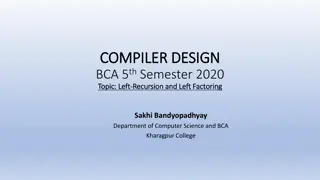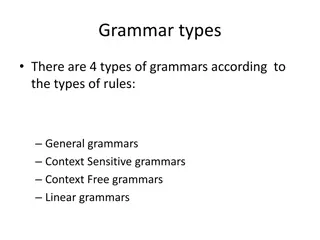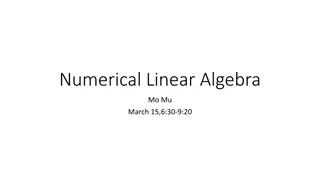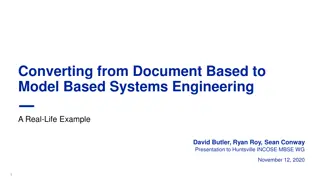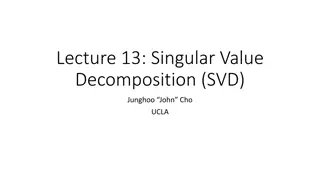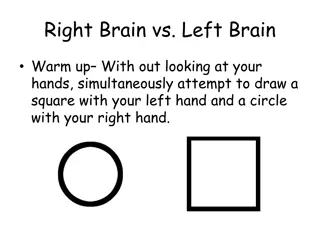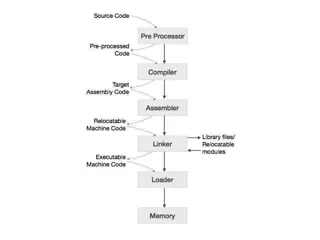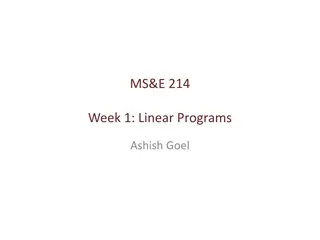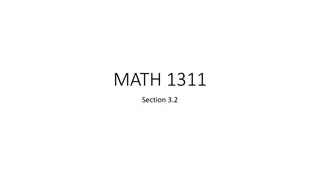Converting Left Linear Grammar to Right Linear Grammar
Learn about linear grammars, left linear grammars, and right linear grammars. Discover why left linear grammars are considered complex and how right linear grammars offer a simpler solution. Explore the process of converting a left linear grammar to a right linear grammar using a specific algorithm.
Download Presentation

Please find below an Image/Link to download the presentation.
The content on the website is provided AS IS for your information and personal use only. It may not be sold, licensed, or shared on other websites without obtaining consent from the author.If you encounter any issues during the download, it is possible that the publisher has removed the file from their server.
You are allowed to download the files provided on this website for personal or commercial use, subject to the condition that they are used lawfully. All files are the property of their respective owners.
The content on the website is provided AS IS for your information and personal use only. It may not be sold, licensed, or shared on other websites without obtaining consent from the author.
E N D
Presentation Transcript
How to convert a left linear grammar to a right linear grammar Roger L. Costello May 28, 2014
Objective This mini-tutorial will answer these questions: 1. What is a linear grammar? What is a left linear grammar? What is a right linear grammar? 2
Objective This mini-tutorial will answer these questions: 1. What is a linear grammar? What is a left linear grammar? What is a right linear grammar? 2. Left linear grammars are evil why? 3
Objective This mini-tutorial will answer these questions: 1. What is a linear grammar? What is a left linear grammar? What is a right linear grammar? 2. Left linear grammars are evil why? 3. What algorithm can be used to convert a left linear grammar to a right linear grammar? 4
Linear grammar A linear grammar is a context-free grammar that has at most one non-terminal symbol on the right hand side of each grammar rule. A rule may have just terminal symbols on the right hand side (zero non-terminals). Here is a linear grammar: S aA A aBb B Bb 5
Left linear grammar A left linear grammar is a linear grammar in which the non-terminal symbol always occurs on the left side. Here is a left linear grammar: S Aa A ab 6
Right linear grammar A right linear grammar is a linear grammar in which the non-terminal symbol always occurs on the right side. Here is a right linear grammar: S abaA A 7
Left linear grammars are evil Consider this rule from a left linear grammar: A Babc Can that rule be used to recognize this string: abbabc We need to check the rule for B: B Cb | D Now we need to check the rules for C and D. This is very complicated. Left linear grammars require complex parsers. 8
Right linear grammars are good Consider this rule from a right linear grammar: A abcB Can that rule be used to recognize this string: abcabb We immediately see that the first part of the string abc matches the first part of the rule. Thus, the problem simplifies to this: can the rule for B be used to recognize this string : abb Parsers for right linear grammars are much simpler. 9
Convert left linear to right linear Now we will see an algorithm for converting any left linear grammar to its equivalent right linear grammar. left linear right linear S Aa A ab S abaA A Both grammars generate this language: {aba} 10
May need to make a new start symbol The algorithm on the following slides assume that the left linear grammar doesn t have any rules with the start symbol on the right hand side. If the left linear grammar has a rule with the start symbol S on the right hand side, simply add this rule: S0 S 11
Symbols used by the algorithm Let S denote the start symbol Let A, B denote non-terminal symbols Let p denote zero or more terminal symbols Let denote the empty symbol 12
Algorithm 1) If the left linear grammar has a rule S p, then make that a rule in the right linear grammar 2) If the left linear grammar has a rule A p, then add the following rule to the right linear grammar: S pA 3) If the left linear grammar has a rule B Ap, add the following rule to the right linear grammar: A pB 4) If the left linear grammar has a rule S Ap, then add the following rule to the right linear grammar: A p 13
Convert this left linear grammar left linear S Aa A ab 14
Right hand side has terminals left linear right linear S Aa A ab S abA 2) If the left linear grammar has this rule A p, then add the following rule to the right linear grammar: S pA 15
Right hand side of S has non-terminal left linear right linear S Aa A ab S abA A a 4) If the left linear grammar has S Ap, then add the following rule to the right linear grammar: A p 16
Equivalent! left linear right linear S Aa A ab S abA A a Both grammars generate this language: {aba} 17
Convert this left linear grammar original grammar left linear S0 S S Ab S Sb A Aa A a S Ab S Sb A Aa A a make a new start symbol Convert this 18
Right hand side has terminals right linear left linear S0 aA S0 S S Ab S Sb A Aa A a 2) If the left linear grammar has this rule A p, then add the following rule to the right linear grammar: S pA 19
Right hand side has non-terminal right linear left linear S0 aA A bS A aA S bS S0 S S Ab S Sb A Aa A a 3) If the left linear grammar has a rule B Ap, add the following rule to the right linear grammar: A pB 20
Right hand side of start symbol has non-terminal right linear left linear S0 aA A bS A aA S bS S S0 S S Ab S Sb A Aa A a 4) If the left linear grammar has S Ap, then add the following rule to the right linear grammar: A p 21
Equivalent! right linear left linear S0 aA A bS A aA S bS S S0 S S Ab S Sb A Aa A a Both grammars generate this language: {a+b+} 22
Will the algorithm always work? We have seen two examples where the algorithm creates a right linear grammar that is equivalent to the left linear grammar. But will the algorithm always produce an equivalent grammar? Yes! The following slide shows why. 23
Generate string p Let p = a string generated by the left linear grammar. We will show that the grammar generated by the algorithm also produces p. 24
Case 1: the start symbol produces p Suppose the left linear grammar has this rule: S p. Then the right linear grammar will have the same rule (see 1 below). So the right linear grammar will also produce p. Algorithm: If the left linear grammar contains S p, then put that rule in the right linear grammar. If the left linear grammar contains A p, then put this rule in the right linear grammar: S pA If the left linear grammar contains B Ap, then put this rule in the right linear grammar: A pB If the left linear grammar contains S Ap, then put this rule in the right linear grammar: A p 1) 2) 3) 4) 25
Case 2: multiple rules needed to produce p Suppose p is produced by a sequence of n production rules: S A1p1 A2p2p1 A3p3p2p1 An-1pn-1 p3p2p1 pnpn-1 p3p2p1 p (p is composed of n symbols) 26
Case 2 (continued) S A1p1 A2p2p1 A3p3p2p1 An-1pn-1 p3p2p1 pnpn-1 p3p2p1 Let s see what right linear rules will be generated by the algorithm for the rules implied by this production sequence. 27
Algorithm inputs and outputs left linear rules algorithm right linear rules 28
Case 2 (continued) S A1p1 A2p2p1 A3p3p2p1 An-1pn-1 p3p2p1 pnpn-1 p3p2p1 S A1p1 algorithm A1 p1 (see 4 below) Algorithm: If the left linear grammar contains S p, then put that rule in the right linear grammar. If the left linear grammar contains A p, then put this rule in the right linear grammar: S pA If the left linear grammar contains B Ap, then put this rule in the right linear grammar: A pB If the left linear grammar contains S Ap, then put this rule in the right linear grammar: A p 1) 2) 3) 4) 29
Case 2 (continued) S A1p1 A2p2p1 A3p3p2p1 An-1pn-1 p3p2p1 pnpn-1 p3p2p1 A1 A2p2 algorithm A2 p2A1 (see 3 below) Algorithm: If the left linear grammar contains S p, then put that rule in the right linear grammar. If the left linear grammar contains A p, then put this rule in the right linear grammar: S pA If the left linear grammar contains B Ap, then put this rule in the right linear grammar: A pB If the left linear grammar contains S Ap, then put this rule in the right linear grammar: A p 1) 2) 3) 4) 30
Case 2 (continued) S A1p1 A1 A2p2 S A1p1 A2p2p1 A3p3p2p1 An-1pn-1 p3p2p1 pnpn-1 p3p2p1 algorithm A1 p1 A2 p2A1 31
Case 2 (continued) S A1p1 A1 A2p2 algorithm A1 p1 A2 p2A1 From A2 we obtain p2p1: A2 p2A1 p2p1 32
Case 2 (continued) S A1p1 A2p2p1 A3p3p2p1 An-1pn-1 p3p2p1 pnpn-1 p3p2p1 A2 A3p3 algorithm A3 p3A2 (see 3 below) Algorithm: If the left linear grammar contains S p, then put that rule in the right linear grammar. If the left linear grammar contains A p, then put this rule in the right linear grammar: S pA If the left linear grammar contains B Ap, then put this rule in the right linear grammar: A pB If the left linear grammar contains S Ap, then put this rule in the right linear grammar: A p 1) 2) 3) 4) 33
Case 2 (continued) S A1p1 A1 A2p2 A2 A3p3 S A1p1 A2p2p1 A3p3p2p1 An-1pn-1 p3p2p1 pnpn-1 p3p2p1 algorithm A1 p1 A2 p2A1 A3 p3A2 34
Case 2 (continued) S A1p1 A1 A2p2 A2 A3p3 algorithm A1 p1 A2 p2A1 A3 p3A2 From A3 we obtain p3p2p1: A3 p3A2 p3p2A1 p3p2p1 35
Case 2 (continued) S A1p1 A2p2p1 A3p3p2p1 An-1pn-1 p3p2p1 pnpn-1 p3p2p1 An-1 pn algorithm S pnAn-1 (see 2 below) Algorithm: If the left linear grammar contains S p, then put that rule in the right linear grammar. If the left linear grammar contains A p, then put this rule in the right linear grammar: S pA If the left linear grammar contains B Ap, then put this rule in the right linear grammar: A pB If the left linear grammar contains S Ap, then put this rule in the right linear grammar: A p 1) 2) 3) 4) 36
Case 2 (concluded) S A1p1 A1 A2p2 A2 A3p3 An-1 pn algorithm A1 p1 A2 p2A1 A3 p3A2 An-1 pn-1An-2 S pnAn-1 From S we obtain pn p2p1: S pnAn-1 pnpn-1An-2 pnpn-1 p3A2 pnpn-1 p3p2A1 pn p3pn-1p2p1 (this is the desired string, p) 37
We have shown that for any string p generated by the left linear grammar, the right linear grammar produced by the algorithm will also generate p. 38
How we understand the algorithm S A1p1 A1 A2p2 A2 A3p3 An-1 pn These rules descend through the non-terminals until reaching a rule with terminals on the RHS, the terminals are output, then we unwind from the descent and output the terminals. algorithm A1 p1 A2 p2A1 A3 p3A2 An-1 pn-1An-2 S pnAn-1 Make the rule with terminals on the RHS the starting rule and output its terminals. Ascend through the other rules. 39
How we understand the algorithm S A1p1 A1 A2p2 A2 A3p3 An-1 pn algorithm If the left linear grammar contains A p, then put this rule in the right linear grammar: S pA A1 p1 A2 p2A1 A3 p3A2 An-1 pn-1An-2 S pnAn-1 40
How we understand the algorithm S A1p1 A1 A2p2 A2 A3p3 An-1 pn algorithm If the left linear grammar contains B Ap, then put this rule in the right linear grammar: A pB A1 p1 A2 p2A1 A3 p3A2 An-1 pn-1An-2 S pnAn-1 41
How we understand the algorithm S A1p1 A1 A2p2 A2 A3p3 An-1 pn If the left linear grammar contains S Ap, then put this rule in the right linear grammar: A p algorithm A1 p1 A2 p2A1 A3 p3A2 An-1 pn-1An-2 S pnAn-1 42
Left-linear grammars generate Type 3 languages Every left-linear grammar can be converted to an equivalent right-linear grammar. Equivalent right-linear grammar means the grammar generate the same language. Right-linear grammars generate Type 3 languages. Therefore, every left-linear grammar generates a Type 3 language. 43
Acknowledgement The algorithm shown in these slides comes from the wonderful book: Introduction to Formal Languages by Gyorgy Revesz 44
